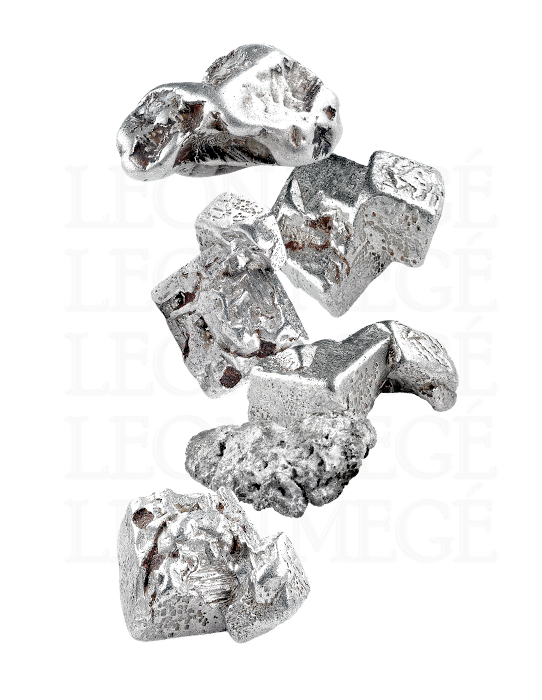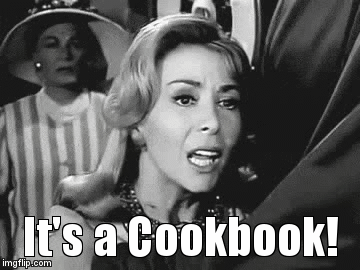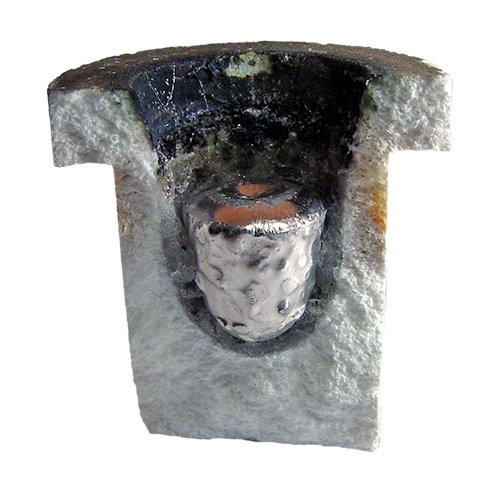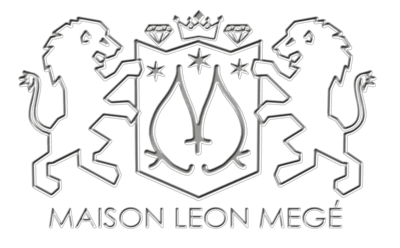
Platinum is a symbol of luxury
Platinum is a noble metal, the king of metals and the metal of kings. It is superior to gold in almost every aspect and vastly superior to white gold. Its purity symbolizes marriage, and its lack of color is perfect for setting colorless diamonds. A platinum ring is nearly twice as heavy as gold and has a pleasant heft and solid feel.
Platinum is so rare that all the platinum ever found can fit into a large room. In comparison, all the gold produced from the dawn of civilization can fill a 30-story building. Platinum jewelry contains 95% pure platinum, making it hypoallergenic. Gold jewelry has less than 75% of pure gold; the rest is mostly copper and silver. Nickel-alloyed white gold used in cheap jewelry is toxic.
Platinum is much denser than white gold and has an invaluable solid feel. When it comes to bespoke production, platinum is the king. Platinum’s extremely high melting point withstands intense heat applications, such as oven temperature sensors and crucibles or coating on ballistic missiles. Its high melting point and excellent malleability make it perfect for hand fabrication. Platinum alloyed with ruthenium has superior hardness, benefiting the jewel’s precision and finish.
White gold is unsuitable for forging due to its low melting point, oxidation, and solder burnout. Hand assembly requires a large number of soldering joints during which white gold solder evaporates. Platinum solder does not have this problem and can be reheated as many times as required.
Platinum is naturally white and does not require repeated plating or “dipping.” Platinum is a self-burnishing metal, which means its surface compresses with age instead of shedding the top layer. Unlike the battered appearance of worn gold jewelry, aged platinum has a dignified appearance. After its surface is evenly dented and punctuated by microscopic dings, it acquires a permanent and highly desirable patina best described as “shabby chic.”
How gold is bleached
Adding other metals to yellow gold (alloying) can change its color. Palladium is the best alloy for turning gold white. Unfortunately, palladium is not cheap; it belongs to the platinum group of non-reactive metals, which are all very expensive. Nickel is cheap, but it causes severe skin allergies affecting roughly 10% of people. Sensitivity to nickel is the common cause of a condition called contact dermatitis. Using nickel in jewelry was officially banned by the European Union in 2009 but remains widespread in the US, which can explain our low math scores.
Virtually all white gold jewelry and watches are coated with rhodium, a bright white metal similar to chromium in color. Rhodium plating gives white gold its unnaturally white finish. Eventually, the plating wears off, revealing the underlying surface’s warm tint.


White Gold is an impostor
At the outbreak of World War II, the United States government declared platinum a strategic resource and banned its use in non-essential applications such as jewelry. White gold was invented in the 1920s to mimic the white color of platinum as a less expensive alternative. After platinum use was restricted to aid the war effort, jewelers turned to white gold as a substitute. After the war, white gold dominated jewelry mass production, and platinum was reserved for high-end work.
Platinum price
Despite all its advantages, the current platinum per-ounce price is significantly below the gold price. Gold prices began to overtake platinum prices right after the global financial crisis of 2008. Two identical rings, one platinum, and one gold, will have different weights because platinum has a higher density. On the other hand, a gold ring weighs less, so its cost is lower than a platinum ring.
Example: 18K gold ring weighs 15 grams. It has 11.3 grams of pure gold, which has a net cost of $573 at the current price of $1,577 per ounce (February 2020). The same exact ring in platinum weighs 20 grams or 19 grams of pure platinum. Its net cost is $593 at the current platinum price of $970 per ounce. (February 2020).

Working with platinum is easier
Hand-forging platinum is easier and less expensive than using white gold. Casting platinum is labor-intensive. It requires special equipment and skills, complicating production and affecting its cost. When a jeweler tells you that a platinum mounting costs more than gold, you can bet you are getting a piece of casting.
Working with platinum is less expensive. The metal costs slightly more, but the labor is cheaper. Platinum allows a bench jeweler to achieve a higher degree of precision. Sharp edges, precise angles, well-defined curves, and clean joints are hallmarks of a hand-forged platinum piece. Working with platinum is a pleasant experience for a bench jeweler. The result is always far superior to anything crafted in white gold. A happy jeweler makes a beautiful ring, and a grumpy jeweler makes a clump of metal.
Platinum vs. Gold Hardness Chart
Metal hardness on the Vickers scale. The higher the number, the harder the alloy. The chart does not specify the difference in hardness between casting and cold-forged metal.
| 110 | Platinum | 5% Ir | Very soft, rarely used |
| 135 | Platinum | Cobalt 4.5% | Production, casting |
| 130 | Platinum | 10% Ir | Casting |
| 190-216 | White gold | 18K Pd | Casting, limited benchwork |
| 150-210 | Yellow gold | 75Au 17Ag 8Cu | Casting, bench work |
| 220-230 | Platinum | 5.0% Ru | Bespoke work |
| 220 | White gold | 18K Ni | Hard and toxic |
| 350 | White gold | 14K Ni | Extremely hard |

Platinum story
Spanish conquistadors dismissed platinum as an annoying impurity in silver, but Europeans eventually got wind of the new white metal, Platina or “little silver” in Spanish. In the mid-1700s, British metallurgist Charles Wood began experimenting with Colombian platinum smuggled to Jamaica. Wood shared his findings with William Brownrigg, who reported to the Royal Society in England about the “new” metal in 1750, noting its unusually high melting temperature. A Spanish explorer Antonio de Ulloa independently “discovered” platinum while on a scientific expedition in Ecuador. In 1751, Swedish scientist Theophil Scheffer categorized platinum as a precious metal with a high melting point and resistance to most types of corrosion.
Fascinating facts about platinum
- Platinum jewelry made its debut in the United States in the early 1900s.
- Unlike gold and silver, platinum can be used for redemption. First Peter 1:18-19 – “For you know that it was not with perishable things such as silver or gold that you were redeemed from the empty way of life handed down to you from your forefathers, but with the precious blood of Christ, a lamb without blemish or defect.”Platinum is not on the list, so we can safely assume it’s safe to use.
- The world’s most precious gemstones and diamonds, including the famous Hope diamond and Dresden Green, are set in platinum.
- During the Second World War, platinum was declared a strategic material and banned in the United States for civilian use.
- Platinum is hypoallergenic and has many medical and dental applications.
- Platinum is used as a catalyst in the manufacture of silicone breast implants.
- In 1557 Italian physician Julius Scaliger described a metal found in Central America by Spanish conquistadors that wouldn’t melt.
He called this new metal “Platina,” meaning “little silver.” Conquistadors thought that the metal was an unripe gold. - In 1888, platinum was discovered in Canada in the nickel-copper ores of Ontario.
- Platinum has been known to Europeans since the 17th century.
However, it was not commercially produced for two centuries until technological advancements came along. - Until 1820 all of the world’s platinum came from Colombia, where hormigas culonas (Fried ants) are considered a delicacy and an aphrodisiac.
- The Imperial State Crown of Great Britain contains platinum, gold, and silver. Queen Elizabeth II owned a platinum stash and used it for her coronation.
- In 2019 only 190 metric tons of platinum were produced worldwide, compared to 3,300 tons of gold or 1.87 billion tons of steel.
- All of the platinum ever mined until now weighs approximately 10,000 metric tons or 300 cubic feet, barely enough to fill a small swimming pool.
- A Spanish shipwreck with cannons containing platinum was found in the Caribbean.
- South Africa produces more than twice as much platinum as all other countries combined.
- In 2019 European jewelers consumed 5.5 metric tons of Japanese 8.5 tons, North American 6.5 tons, and Chinese 35.5 tons of platinum.
- There are 3 to 7 grams of platinum in a typical catalytic converter.
- For a long time, platinum was discarded as a metal that was too hard to use.
- Some anti-cancer drugs contain platinum because of the metal’s non-reactive properties.
- Half of the annual production of platinum is used for industrial purposes, and only 30% is consumed as jewelry.
- Platinum’s melting point is 3,221.6°F (1,772°C). Its boiling point is 6,920.6°F (3827°C ). Platinum will not boil in the middle of a sunspot, a chilly 6,380°F (3,527°C).
- Platinum density (specific gravity) is 21.45 g/cm3, heavier than gold and twice as heavy as silver.
There is always more platinum in a platinum ring than gold in a gold ring. - Platinum is 4.3 on the Mohs scale, harder than the gemstone fluorite (4) and almost as hard as turquoise (5).
- Platinum’s purity symbolizes the sanctity of marriage. A platinum engagement ring owner is three times less likely to get a divorce.
- The first-ever platinum coins were struck in Russia in 1828 when Czar Nicholas authorized three denominations: 3-, 6-, and 12 rubles. Only eleven 12-ruble coins are known to exist today. One of them was recently sold for $164,600 at an auction in Tokyo.
- Alfred Cartier claimed he was the first to figure out how to make platinum jewelry.
- Louis Cartier was the first to introduce the combination of platinum and diamonds in garland-style jewelry. In 1898 he made a line of platinum jewelry and, in 1907, introduced the world’s first platinum watch.
- Platinum jewelry first appeared around 1780 in the court of Louis XVI of France. He was so impressed with platinum that he proclaimed the white metal the only one fit for royalty.
- Platinum is one of six noble metals: platinum, palladium, ruthenium, rhodium, osmium, and iridium – together known as the platinum group together with gold, silver, and copper are noble metals.
- The opposite of a noble metal is a base metal. Not all corrosion-resistant metals are noble metals. Titanium, niobium, and tantalum are corrosion-resistant, yet they are not noble metals.
- Platinum is strong, malleable, and durable, making it suitable for hand fabrication. Its neutral color is ideal for holding colorless diamonds without casting a yellow tinge.
- Before the 15th century, South American natives could not even melt platinum, yet they were using it.
- Until 1924, when it was discovered in South Africa, Russia produced more than 90% of platinum.
- The Art Deco movement fueled the rise of platinum’s popularity. From the beginning of the 20th century, platinum became the metal of choice for the finest jewelry.
How do you say “platinum” in other languages:
Albanian : Platini
Arabic : بلاتين
Armenian : Պլատին
Basque : Platino
Belarusian : Плаціна
Bengali : প্লাটিনাম
Bosnian : Platina
Bulgarian : Платина
Catalan : Platí
Chuvash : Платина
Corsican : Platinu
Croatian : Platina
Czech : Platina
Danish : Platin
Dutch : Platina
Haitian : Platin
Hebrew : פלטינה
Hungarian : Platina
Icelandic : Platína
Ido : Platino
Indonesian : Platina
Interlingua : Platino
Italian : Platino
Japanese : 自然白金
自然 白金
Korean : 백금
Kurdish (Latin Script) : Platîn
Latin : Platinum
Latvian : Platīns
Lithuanian : Platina
Lojban : jinmrplati
Low Saxon/Low German : Platin
Luxembourgish : Platin
Macedonian : Платина
Malayalam : പ്ലാറ്റിനം
Manx : Platinum
Norwegian : Platina
Norwegian (Nynorsk) : Platina
Occitan : Platin
Polish : Platyna
Portuguese : Platina
Quechua : Qullqiya
Romanian : Platină
Russian : Платина
Serbian : Платина
Serbo-Croatian : Platina
Sicilian : Plàtinu
Simplified Chinese : 自然铂
Slovak : Platina
Slovenian : Platina
Spanish : Platino
Swahili : Platini
Swedish : Platina
Tajik (Cyrillic Script) : Платина
Tamil : பிளாட்டினம்
Thai : แพลทินัม
Traditional Chinese : 自然白金
Turkish : Platin
Ukrainian : Платина
Vietnamese : Bạch kim
